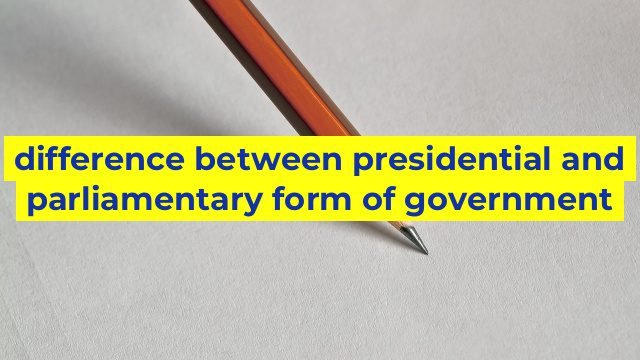Difference between Presidential and Parliamentary Form of Government
Presidential and Parliamentary form of government are two kinds of political systems that are widely used around the world. While both of these systems have their own advantages and disadvantages, there are noticeable differences between the two. In this article, we’ll explore those differences.
Definition of Presidential and Parliamentary form of Government
Presidential government is the system in which a president is the head of state and is responsible for performing executive functions. The president has a fixed term of office and is elected by the people in a direct or indirect election. The government is divided into three branches – the executive, legislature, and the judiciary.
On the other hand, in a Parliamentary government, the head of state is usually a monarch, and the real power is vested with the Prime Minister and the Cabinet. The Prime Minister is appointed by the ruling party or the coalition of parties that have a majority in the parliament.
Electoral Process
One of the main differences between presidential and parliamentary form of government is the way the leader is elected. In the presidential system, the leader is elected in a direct election by the people. The election process is usually a lengthy one, and campaigning plays a significant role in drumming up support from the voters. The winner is then sworn in as the leader, and he/she exercises executive authority for a fixed term of office.
In contrast, the electoral process in Parliamentary form of government is more indirect. The people vote for their representatives in the parliament, who, in turn, elect the Prime Minister. This form of government is more streamlined and, as a result, takes less time to get the leader in power.
Relationship Between the Legislature and the Executive
Another significant difference between presidential and parliamentary form of government is the relationship between the legislature and the executive. In a presidential government, the two branches are separate and independent of each other. The president is elected by the people and has to work with the legislature to pass laws and enact policies. However, the president alone has the power to veto bills and can also issue executive orders that are binding on the government.
On the other hand, in a parliamentary system, the relationship between the legislative and executive branches is more intertwined. The prime minister and the cabinet are members of the parliament themselves, and they need the support of the parliament to get their policies enacted. The parliament can oust the prime minister through a vote of no confidence, and the prime minister can also dissolve the parliament if he/she feels they no longer have the support to govern.
Conclusion
While both presidential and parliamentary systems of government have their own pros and cons, it is essential to understand their differences to make an informed decision about what system is best suited for a country. A presidential system might work in a country with a strong constitution and a culture of individualism, while a parliamentary system might be better suited for a country with a diverse population and multiple political parties.
Ultimately, the choice between the two systems comes down to what works best for the country and the people who live in it.
Table difference between presidential and parliamentary form of government
| Presidential Form of Government | Parliamentary Form of Government |
|---|---|
| The President is the head of state and government. | The Prime Minister is the head of government while the monarch or president is the head of state. |
| The President is elected through a direct vote by the people. | The Prime Minister is elected by the parliament or legislature. |
| The President has executive powers and is not subject to the legislature. | The Prime Minister and their cabinet members are members of the legislature and are accountable to it. |
| The President has the power to veto laws passed by the legislature. | The Prime Minister does not have that power. Instead, the monarch or president has the power to veto laws. |
| The President and their cabinet members are not accountable to the parliament. | The Prime Minister and their cabinet members are accountable to the parliament and can be removed through a vote of no confidence. |
| The President and their cabinet members are not members of the parliament. | The Prime Minister and their cabinet members are members of the parliament. |


